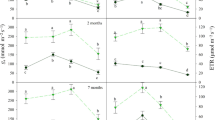Summary
Monoterpenes in needles of Picea abies (L.) Karst. were studied to reveal whether or not the symptoms of forest decline observed in three mountain regions of South Germany (Bavaria) — needle loss and needle yellowing — are related to changes in the amounts of all or individual terpenes. The nutrient supply of the needles was examined in addition to the terpene concentrations, since the disease symptom montane yellowing is often associated with mineral deficiency. At two of the eight locations, trees exhibited Mg-deficiency, at one location K-deficiency was observed, and at another location the S-content of the needles indicated SO2-pollution. Using various statistical methods of analysis, no correlation was observed between the mineral element content of the needles, the percentage of needle loss and either the absolute or percentile terpene amounts stored within the needles. This finding is independent of needle age, date of sampling and terpene pattern. Concerning needle yellowing, the data show a tendency towards a reduction of the terpene concentrations in needles originating from branches with partly yellow needles compared to needles from exclusively green-needled branches. In spite of the fact that only 2-year-old and older needles show the disease symptom of yellowing, the terpene level is reduced even in still green, juvenile and 1-year-old needles. No terpene was found to be an indicator for early recognition of injury.
Similar content being viewed by others
References
Bayerisches Landesamt für Umweltschutz (1985, continued) Lufthy-gienischer Monatsbericht, W-8000 München, Rosenkavalierplatz 3, FRG
Bernard-Dagan C, Pauly G, Marpeau A, Gleizes M, Carde JP, Baradat P (1982) Control and compartmentation of terpene biosynthesis in leaves of Pinus pinaster. Physiol Veg 20: 775–795
Bucher JB (1982) Einfluß von SO2 auf Terpenemissionen von Kiefern (P. sylvestris). XII International meeting for specialists in air pollution damaged forests IUFRO. Oulu-Finland, pp 23–29
Cobb FW, Zavarin E, Bergot J (1972) Effect of air pollution on the volatile oil from leaves of Pinus ponderosa. Phytochemistry 11: 1815–1818
Croteau R (1984) Biosynthesis and catabolism of monoterpenes. In: Nes WD, Fuller G, Tsai L-S (eds) Isoprenoids in plants. Dekker, New York, pp 31–64
Croteau R, Johnson MA (1984) Biosynthesis of terpenoids in glandular trichomes. In: Rodriguez E, Healey PL, Metha I (eds) Biology and chemistry of plant trichomes. Plenum, New York, pp 133–185
Cyrkal H (1959) Biochemische Diagnose an Fichten in Rauchgebieten. Berichte Tschechoslowakische Akademie Landwirtschaftswissen-schaften, Sektor Forstwesen 5: 1033–1048
Dässler H-G (1964) Einfluß des Schwefeldioxids auf den Terpengehalt von Fichtennadeln. Flora 154: 376–382
Forschungsbeirat Waldschäden/Luftverunreinigungen der Bundesre-gierung und der Länder (1986) 2. Bericht. Kernforschungszentrum Karlsruhe, Karlsruhe: 99
Hanover JW (1975) Physiology of tree resistance to insects. Annu Rev Entomol 20:75–95
Ishikawa M, Shuto Y, Watanako H (1986) β-Myrcene, a potent attractant component of pine wood for the pine wood nematode, Bursaphelenchus-xylophis. Agric Biol Chem 50: 1863–1866
Jüttner F (1988) Changes of monoterpene concentrations in needles of pollution-injured Picea abies exhibiting montane yellowing. Physiol Plant 72: 48–56
Kaupenjohann M, Hantschel R, Horn R, Zech W (1985) Nährstoffversor-gung gedüngter, unterschiedlich geschädigter Fichten auf immissionsbelasteten Standorten in NO-Bayern. Mitt Dtsch Bodenk Ges 43: 969–974
Krupa S, Nylund JE (1972) Studies on ectomycorrhizae in pine. III. Growth and inhibition of two root pathogenic fungi by volatile organic constituents of ectomycorrhizal root systems of Pinus sylvestris L. Eur J For Pathol 2: 88–94
Lehtiö H (1981) Effect of air pollution on the volatile oil in needles of Scots pine (Pinus sylvestris). Silva Fenn 15: 122–129
Lufthygienische Jahresberichte (1985, 1986) Schriftenreihe Bayerisches Landesamt für Umweltschutz Heft 75, 76
Merk L, Kloos M, Schönwitz R, Ziegler H (1988) Influence of various factors on quantitative and qualitative composition of leaf monoterpenes of Picea abies (L.) Karst. Trees 2: 45–51
Raffa KF, Berryman AA, Simasko J, Ceal W, Wong BL (1985) Effects of grand fir monoterpenes on the fir engraver, Scolytus ventralis (Coleoptera: Scolytidae). Environ Entomol 14: 552–556
Rudioff von E (1975) Seasonal variation of terpenes in the leaves, buds, and twigs of blue spruce (Picea pungens). Can J Bot 53: 2978–2982
Ryker LC (1984) Acoustic and chemical signals in the life cycle of a beetle. Sci Am 250: 112–123
SAS Institute Inc (1985) SAS user's guide: Statistics (1985). Cary, NC
Schäfer PR, Hanover JW (1986) Taxonomic implications of monoterpene compounds of blue and Engelman spruce. For Sci 32: 725–734
Schönwitz R, Merk L, Ziegler H (1987) Naturally occurring monoterpenoids in needles of Picea abies (L.) Karst. Trees 1: 88–93
Schönwitz R, Kloos M, Merk L, Ziegler H (1990a) Patterns of monoterpenes stored in the needles of Picea abies (L.) Karst. from several locations of montainous regions of South Germany. Trees 4: 27–33
Schönwitz R, Lohwasser K, Kloos M, Ziegler H (1990b) Seasonal variation in the monoterpenes in needles of Picea abies (L.) Karst. Trees 4: 34–40
Schramel P (1988) ICP and DCP emission spectrometry for trace element analysis in biomedical and environmental samples. Spectrochem Acta 43: 881–896
Streletzki HW (1983) Immissionsökologische Waldschadenserfassung in Niedersachsen. Forst-Holzwirt 38: 554–558
Tominaga Y, Yamamoto M, Kuwahara Y, Sugawara R (1984) Behavioral responses of the pine wood nematode to terpenes. Agric Biol Chem 48: 519–520
Vassiliev AE, Carde JP (1976) Effects du gemmage sur l'ultrastructure des cellules sécretices des cannaux de l'écoce des tiges de Pinus sylvestris et Picea abies (L.) Karst. Protoplasma 89: 41–48
Zavarin E, Snajberk K (1973) Geographical variability of monoterpenes from cortex of Pseudotsugamenziesii. Pure Appl Chem 34: 411–433
Zech W, Horn R, Kaupenjohann M, Hantschel R (1986) Oberwarmen-steinach, Wülfersreuth und Selb. Standortsabhängige Schäden an Fichten. In: Papke HE, Krahl-Urban B, Peters K, Schimansky C (eds) Waldschäden. Kernforschungsanlage Jülich GmbH, Jülich: 66–69
Author information
Authors and Affiliations
Rights and permissions
About this article
Cite this article
Schönwitz, R., Merk, L., Kloos, M. et al. Influence of needle loss, yellowing and mineral content on monoterpenes in the needles of Picea abies (L.) Karst.. Trees 5, 208–214 (1991). https://doi.org/10.1007/BF00227527
Received:
Accepted:
Issue Date:
DOI: https://doi.org/10.1007/BF00227527




